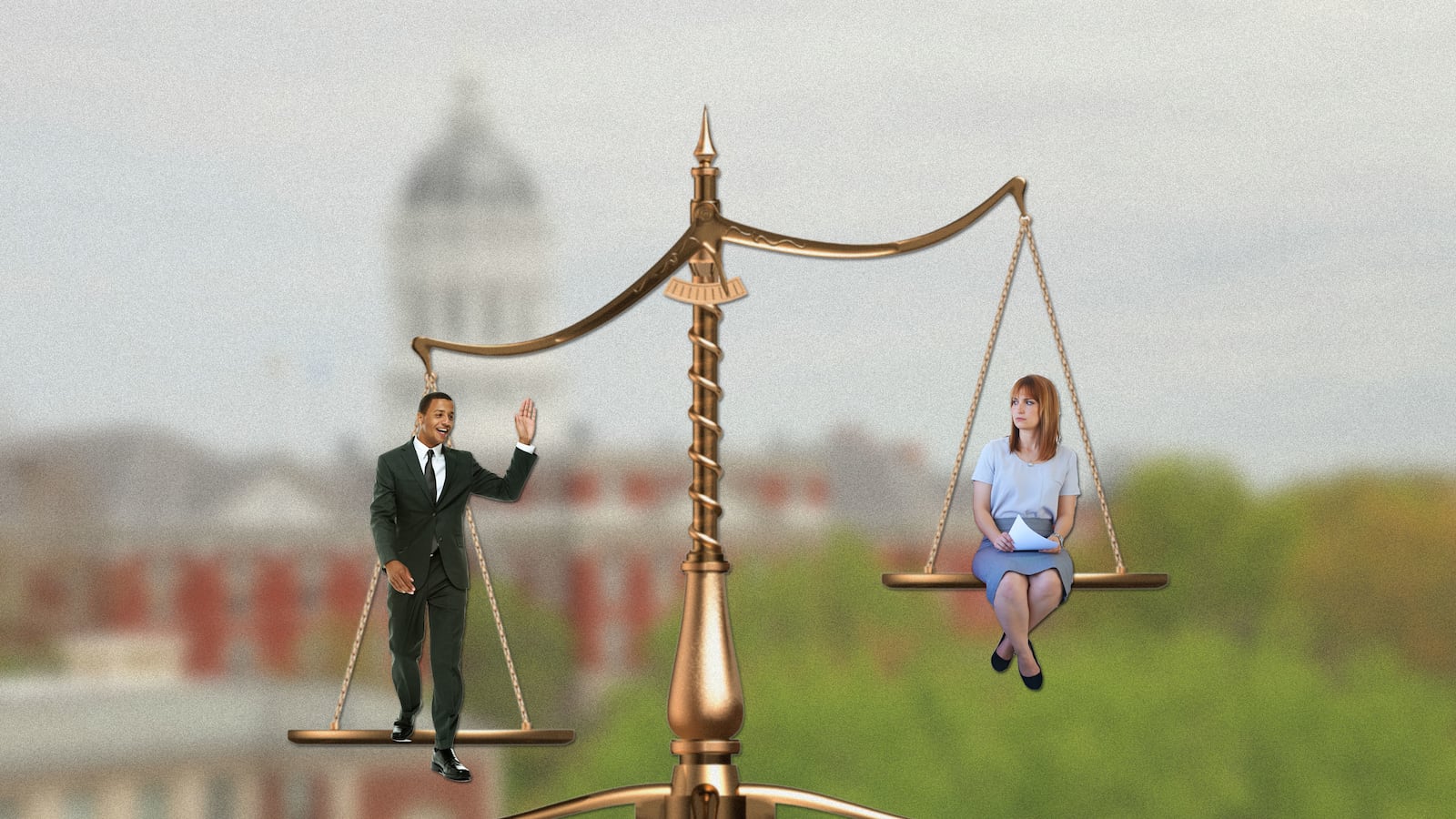The academy might seem like a bastion of American liberalism but an extensive database of faculty salaries compiled by The Chronicle of Higher Education paints a damning picture of gender inequality at U.S. colleges and universities.
Not only does the data reveal a substantial gender pay gap at both private and public schools, it also shows that male-dominated college faculties disproportionately rely on the labor of women in instructor and lecturer positions.
Women may keep our colleges running but the American university is still an old boys’ club.
The Chronicle of Higher Education’s new tool displays faculty and staff salary data from over 4,700 colleges and universities stretching from 2003 to 2013. The federal data powering the database isn’t brand new but it provides the starkest and most accessible visualization yet of the gendered distribution of labor in the American academy.
In 2013, women constituted just 30.4 percent of full professors at four-year private colleges and 29.1 percent at four-year public colleges. These numbers are up from 23.7 percent and 22.4 percent a decade prior but they are still deplorable, especially considering that they mirror gender representation in the much-scrutinized tech industry.
At Twitter, for example, women make up only 21 percent of leadership roles overall. Facebook fares slightly better with women in 23 percent of senior-level positions. The tech sector has long been pilloried for these figures—even prompting Intel to pledge $300 million earlier this year to address the lack of diversity in the industry—but college faculties are managing little better and receiving much less tongue-lashing.
The Chronicle database does show that women are more than equally represented in lecturer and instructor positions, but these are often part-time or adjunct roles with no benefits and no access to the tenure track. In other words, women end up doing the bulk of academia’s dirty work—despite being more likely to graduate from college than men and far outnumbering them in graduate school.
To make matters worse, these female lecturers and instructors are generally paid less than their male counterparts at four-year schools. At four-year private colleges, for example, the average 2013 salary for a male lecturer is $61,567, while the average for a female lecturer sits at $56,594. Even at the lowest rungs of the academic ladder, women are still making less than men.
In a statement to The Daily Beast, Service Employees International Union (SEIU) President Mary Kay Henry emphasizes that salaries for adjunct professors are not livable, a problem that is only exacerbated by the gender pay gap: “Time and again we hear from adjunct professors across the country—dedicated teachers committed to educating our next generation—that no matter how hard they work, they still don’t make enough to make ends meet for their families.”
In the past year, the plight of the adjunct has broached mainstream news but relatively less attention has been paid to the fact that this growing and underpaid workforce is mostly made up of women. The National Center for Education Statistics (NCES) reports that the percentage of faculty who are part-time increased from 35 to 50 percent from 1991 to 2011 and, according to analysis of the NCES data provided by SEIU, women are the majority of these part-time faculty. Women are also more likely to be part-time faculty than they are to be full-time. Of the roughly half a million women in faculty positions in 2012, over 275,000 were working part-time. As universities cut costs by upping their part-time labor force, women are the ones paying the price, working the worst jobs in the academy for less money with little job security.
But the gender pay gap is even more dramatic for full-time professors than it is at the bottom of the academic workforce. According to the Chronicle database, the average female full-time professor at a four-year private college made just 86.1 percent as much as a male colleague in 2013. The situation is better at public schools—where the average female full-time professor makes 87.4 percent as much as a male colleague—but not by much. These figures are actually down from 87.1 percent and 88.5 percent respectively in 2003. Granted, 87 cents on the dollar is still much higher than the oft-disputed 77-cent wage gap figure but, in college-speak, it’s still a B+, not in the A range.
The pay gap persists even at liberal Ivy League institutions. Male full professors at Dartmouth College made an average of nearly $28,000 more than their female counterparts in the 2013-2014 academic year. Harvard may have a women’s center, a Women and Public Policy Program, a women’s studies program, and two women’s mentoring programs but they paid male full professors an average of about $15,000 more than female full professors that same year. The pay gaps at these elite universities are better than the average—for full professors at Harvard, the difference amounts to 92.6 cents on the dollar—but everyone knows that at an Ivy League school, an A- is a shameful grade.
In a particularly cruel bit of irony, too, male professors even out-earn female professors at some women’s colleges. In the 2013-2014 academic year at Smith College, male professors, associate professors, assistant professors, and lecturers all made more on average than their female counterparts. At other women’s schools, like Mount Holyoke, for example, the pay gap is not a complete coup for men, affecting only women at the full professor rank.
John Barnshaw, senior higher education researcher for the American Association of University Professors (AAUP), notes that the pay gap at the full professor rank will be the slowest to change.
“That’s in part because, historically, there were more male professors than women professors. As they stay—as they earn the rank of professor—their value is going to compound over time,” Barnshaw tells The Daily Beast in a phone interview.
Jonah Newman, formerly the database reporter for the Chronicle, also notes in a 2014 data analysis that universities may, in part, be reeling from the residual impact of the more overtly sexist hiring practices of yesteryear. Both he and Barnshaw point to the increasing number of women in tenure-track assistant professor positions as a sign of potential progress.
The 2013 pay gaps between men and women at the assistant professor level are indeed less dramatic—92.5 percent at four-year public colleges and 93.5 percent at four-year private colleges—but if parity has not yet been reached at the entry level for tenure, it will take even longer for equality to reach the highest tiers of academe.
Add to that the fact that many women perceive a tenure-track job and a family to be mutually exclusive and change could prove to be more glacial still. Women seeking tenure-track positions in STEM disciplines reportedly feel this problem with particular acuteness. Over the next decade, the pay gap will rise or fall depending on the ratio of women leaving the academy to women receiving promotions to full professor.
The new Chronicle database presents the American academy at a crisis point, both in terms of labor practices and gender inequality. At the moment, substantially narrowing the pay gap at U.S. schools seems like a long shot: Women will have to survive in part-time jobs with no benefits until they land assistant professor positions only to end up navigating work-life balance on the tenure track. But perhaps it’s bitterly fitting that closing the gender pay gap in the academy means more work for women.






